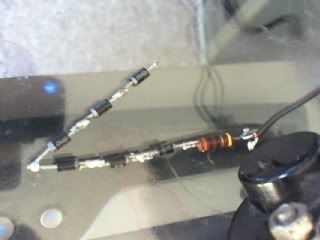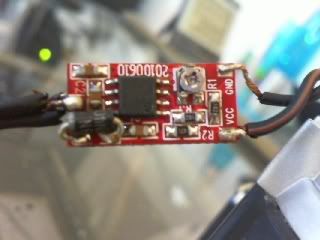- Joined
- Mar 2, 2011
- Messages
- 19
- Points
- 0
Hey, people. I'm new to the whole laser community and as you can see, this is my first post on the forum. So I was wondering if someone could answer me a couple of questions about my first "build".
I'm trying to set current on an AixiZ driver for a 803t? 150mw Blu-ray diode. I made a testload from salvaged diodes (3x1N4004, 2x1N4001, 1x1N4007, all of which are almost the same according to datasheets I've come across) and an old 11.2 ohm resistor, as registered on my DMM (although it's marked as 1 ohm - brown, black, black stripes). I'm actually measuring current, not voltage. I'm using analog ampere meter. With the test load in series, it shows about 97-98 mA. Then I tried to take a measurement without a test load and it shows 100 mA. Now, if the resistor is indeed ~10 ohm, then shouldn't the reading with load be 10 times smaller? I also gotta mention that my DMM is acting funny (showing random 0.1 - 0.3 volts/amps when probes aren't even touching anything), so it may be out of calibration, so 1ohm-marked resistor may really be a 1ohm resistor. But even so, why is the mA reading almost the same with test load as without?
Test load

One of my early mistakes - I connected the driver to the batteries with wrong polarity. Something blew. I assume it was a fuse of some sort. I saw that it had same white stripe on one side as diodes do, so I replaced it with some diode I salvaged from somethig. The whole thing does work, with the Blu-ray, but I don't want to make anything permenant out of it until I set the current right.

I'm trying to set current on an AixiZ driver for a 803t? 150mw Blu-ray diode. I made a testload from salvaged diodes (3x1N4004, 2x1N4001, 1x1N4007, all of which are almost the same according to datasheets I've come across) and an old 11.2 ohm resistor, as registered on my DMM (although it's marked as 1 ohm - brown, black, black stripes). I'm actually measuring current, not voltage. I'm using analog ampere meter. With the test load in series, it shows about 97-98 mA. Then I tried to take a measurement without a test load and it shows 100 mA. Now, if the resistor is indeed ~10 ohm, then shouldn't the reading with load be 10 times smaller? I also gotta mention that my DMM is acting funny (showing random 0.1 - 0.3 volts/amps when probes aren't even touching anything), so it may be out of calibration, so 1ohm-marked resistor may really be a 1ohm resistor. But even so, why is the mA reading almost the same with test load as without?
Test load

One of my early mistakes - I connected the driver to the batteries with wrong polarity. Something blew. I assume it was a fuse of some sort. I saw that it had same white stripe on one side as diodes do, so I replaced it with some diode I salvaged from somethig. The whole thing does work, with the Blu-ray, but I don't want to make anything permenant out of it until I set the current right.




